
No.001 Datsun 12 Phaeton (1933 : Type 12)
Datsun’s roots go all the way back to 1914 when the Kwaishinsha Co. manufactured their first car, the DAT (D, A, and T being the initials of the three investors). It was followed by a smaller car that was to be christened DATSON (son of DAT), but because of the inauspicious associations of “son” (sounds like the Japanese word for “loss”), this was changed to DATSUN when the vehicle went on sale in 1932.
Overall length………………………………..2,710mm
Overall width…………………………………1,175mm
Wheelbase…………………………………….1,918mm
Tread……………………………………………965mm
Engine………………………………………….Water-cooled, 4 cylinders, SV
Displacement………………………………..748cc
Max. power……………………………………9kW (12PS)
Price……………………………………………..¥1,350 (Phaeton, Osaka delivery)
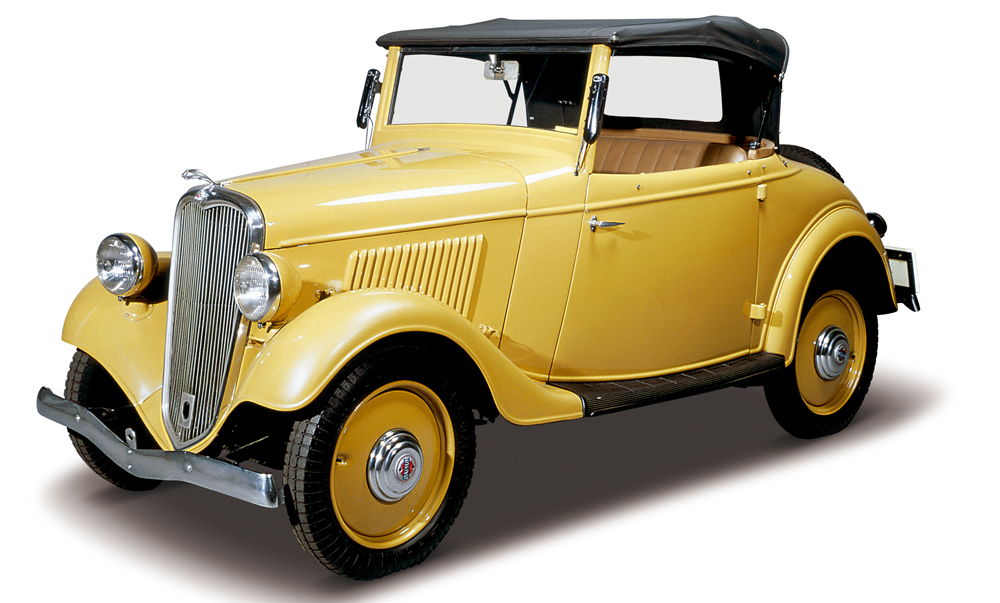
No.002 Datsun 14 Roadster (1935 : Type14)
Jidosha-Seizo Co., Ltd. established in December 1933, became Nissan Motor Co.,Ltd in the following year and started full-scale production. At the company’s new factory in Yokohama, the first car to come off the line was this “14”(April 1935). It was powered by a new 722cc, 15ps engine. A distinguishing feature is the beautiful rabbit mascot created by Ryuichi Tomiya, who worked on the body design.
Overall length………………………………….2,800mm
Overall width…………………………………..1,200mm
Wheelbase………………………………………1,980mm
Tread (front/rear)……………………………980/1,016mm
Engine……………………………………………Type 7 (4-cyl. in line, SV)
Displacement / Max. power………………722cc / 11kW (15PS)
Seating capacity……………………………….2
Top speed……………………………………….80km/h
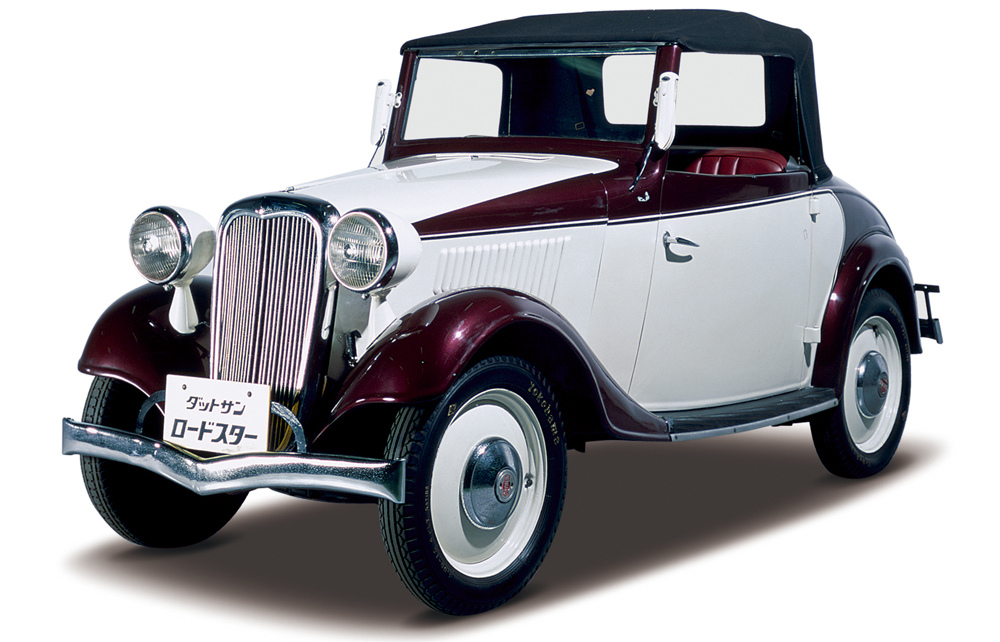
No.246 Datsun 14 Roadster (1935 : Type 14)
The first-generation Datsun launched in 1932 had a 747cc, 10ps engine, but the “14”, which appeared in 1935, was powered by a 722cc, 15ps engine. The “14”‘s main feature was the heart-shaped grille, inherited from the “13” and further refined to make it look more oval. This roadster accommodated two, but it had a rumble seat for an extra passenger in the back.
Overall length………………………………….2,800mm
Overall width…………………………………..1,200mm
Wheelbase………………………………………1,980mm
Tread (front/rear)……………………………980/1,016mm
Engine……………………………………………Type 7 (4-cyl. in line, SV)
Displacement / Max. power………………722cc / 11kW (15PS)
Seating capacity……………………………….2
Top speed……………………………………….80km/h
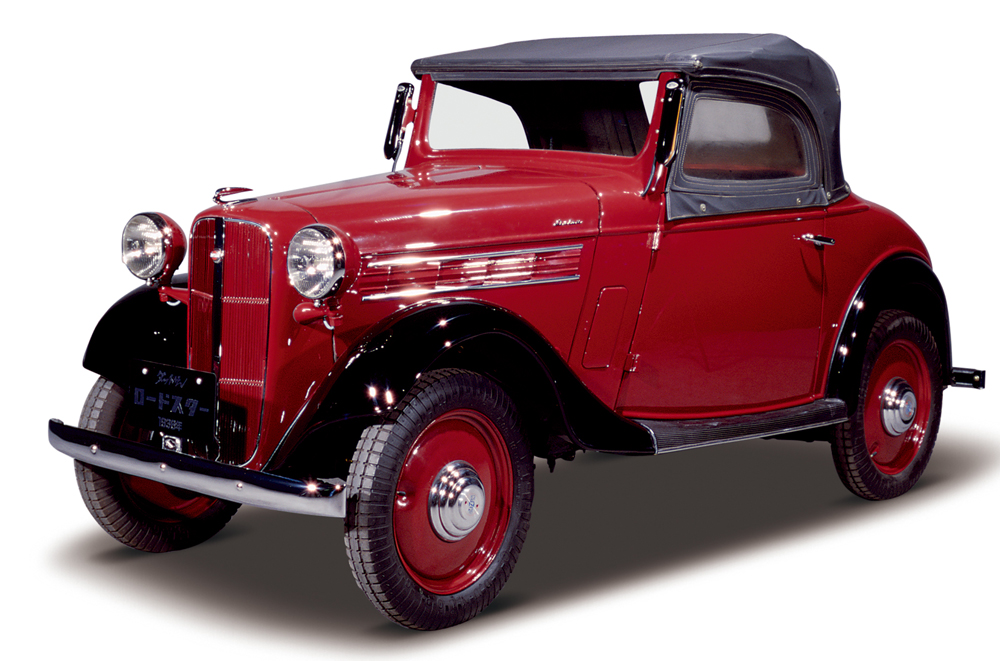
No.004 Datsun 15 Roadster (1936 : Type 15)
This roadster had the same 722cc engine as the “14”, but by increasing the compression ratio from 5.2 to 5.4, maximum horsepower was increased by 1ps to 16. As with the phaeton, it was distinguished by the square badge on the radiator grille and louvers on the side of the hood that look as if they open and close. Due to changes in the law, from the “15” onwards, the spare tire could be mounted on the outside of the trunk.
Overall length………………………………….2,790mm
Overall width…………………………………..1,190mm
Wheelbase………………………………………2,005mm
Tread (front/rear)……………………………1,038/1,049mm
Curb weight…………………………………….500kg
Engine…………………………………………..Type 7 (4-cyl. in line, SV), 722cc
Max. power…………………………………….12kW (16PS)/3,600rpm
Max. torque…………………………………….37Nm (3.8kgm)/2,000rpm
Top speed……………………………………….80km/h
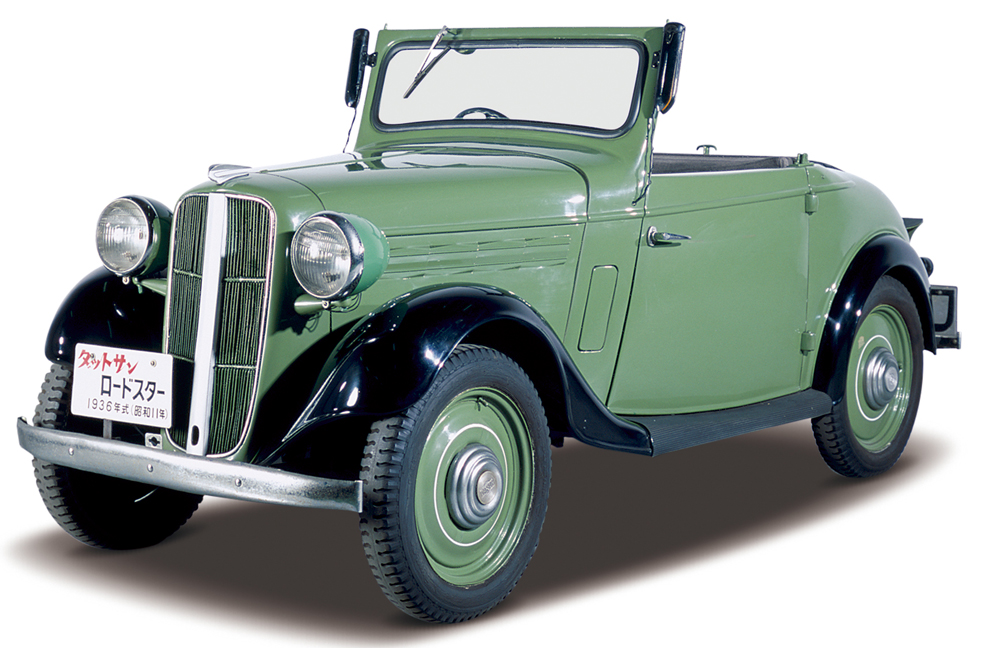
No.245 Datsun 15 Roadster (1936 : Type 15)
With the “15”coupe, launched in 1936, there was a 4-model lineup: the sedan, phaeton, roadster and coupe. Due to changes in the law, the roadster’s spare tire could be mounted outside the trunk and therefore the trunk and the rumble seat could be used more freely. The car was powered by a 722cc, 16ps engine.
Overall length…………………………………..2,790mm
Overall width……………………………………1,190mm
Wheelbase………………………………………2,005mm
Tread (front/rear)……………………………..1,038/1,016mm
Curb weight…………………………………….500kg
Engine……………………………………………Type 7 (4-cyl. in line, SV), 722cc
Max. power……………………………………..12kW (16PS)/3,600rpm
Max. torque…………………………………….37Nm (3.8kgm)/2,000rpm
Top speed………………………………………80km/h
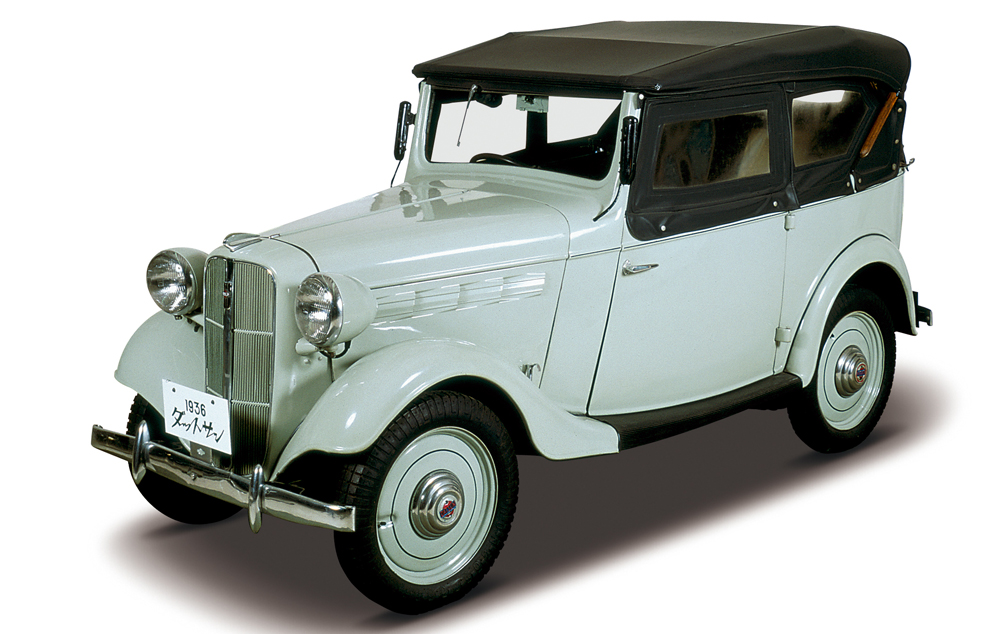
No.003 Datsun 15 Phaeton (1936 : Type 15)
The “15”, which appeared in May 1936, uses the same 722cc (Type 7) engine as the “14”, but the compression ratio was raised from 5.2 to 5.4 to turn it into a 16ps engine. The square badge on the upper left of the radiator grille is a feature of the “15”, which also had horizontal louvers on the side of the hood of a more elaborate design than the simple vertical ones on the “14”.
Overall length…………………………………..3,187mm
Overall width……………………………………1,190mm
Wheelbase……………………………………….2,005mm
Tread (front/rear)……………………………1,038/1,049mm
Engine……………………………………………Type 7 (4-cyl. in line, SV), 722cc
Max. power……………………………………..12kW (16PS)/3,600rpm
Max. torque…………………………………….37Nm (3.8kgm)/2,000rpm
Seating capacity………………………………4
Top speed………………………………………80km/h
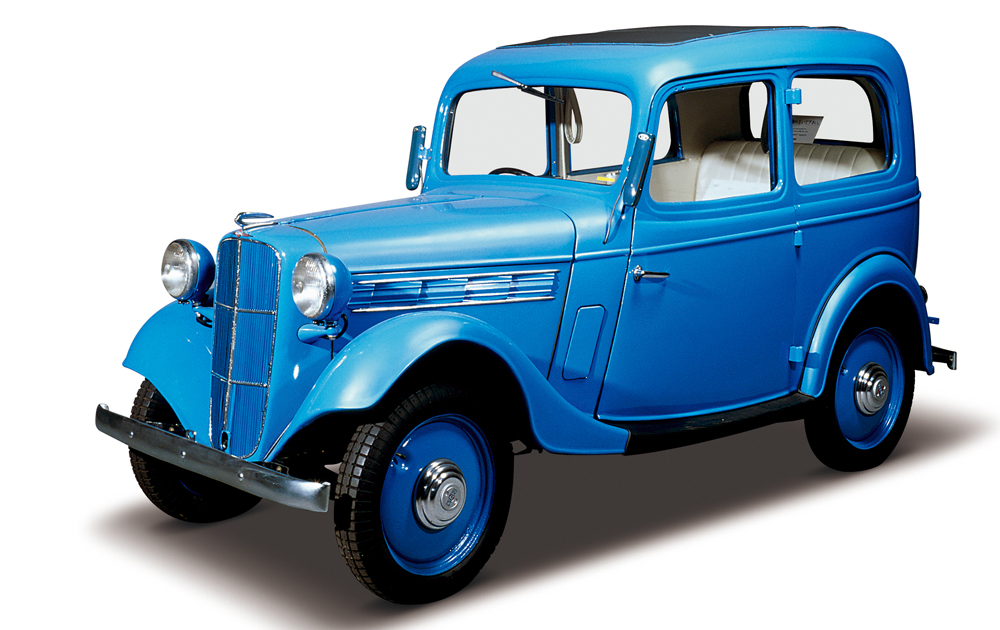
No.005 Datsun 16 Sedan (1937 : Type 16)
The Type “16”, launched in April 1937, had the same 722cc, 16ps engine as the “15”. The radiator grille had a more delicate design (compared to the previous type), and the chrome trim molding ran above and below the side louvers, instead of running through the center. Also the mascot on the front of the hood and the design of the Datsun mark were changed.
Overall length…………………………………3,120mm
Overall width………………………………….1,190mm
Wheelbase………………………………………2,005mm
Tread (front/rear)…………………………..1,038/1,049mm
Curb weight……………………………………610kg
Engine…………………………………………..Type 7 (4-cyl. in line, SV), 722cc
Max. power…………………………………….12kW (16PS)/3,600rpm
Seating capacity……………………………..4
Top speed………………………………………80km/h

No.234 Datsun 17 Phaeton (1938 : Type 17)
The first generation Datsuns, starting with the “10” in 1932, had evolved into the “17” by 1938. Starting with “14”, launched in 1935, these were powered by a 722cc, 15ps engine. “17”, the final model, appeared in 1938. Two years after the start of the Sino-Japanese War, which led to shortages of materials, the cabin interior was finished very simply.
Overall length…………………………………3,187mm
Overall width………………………………….1,190mm
Wheelbase……………………………………..2,005mm
Tread (front/rear)…………………………..1,038/1,049mm
Engine…………………………………………..Type 7 (4-cyl. in line, SV), 722cc
Max. power…………………………………….12kW (16PS)/3,600rpm
Seating capacity……………………………..4
Top speed………………………………………80km/h
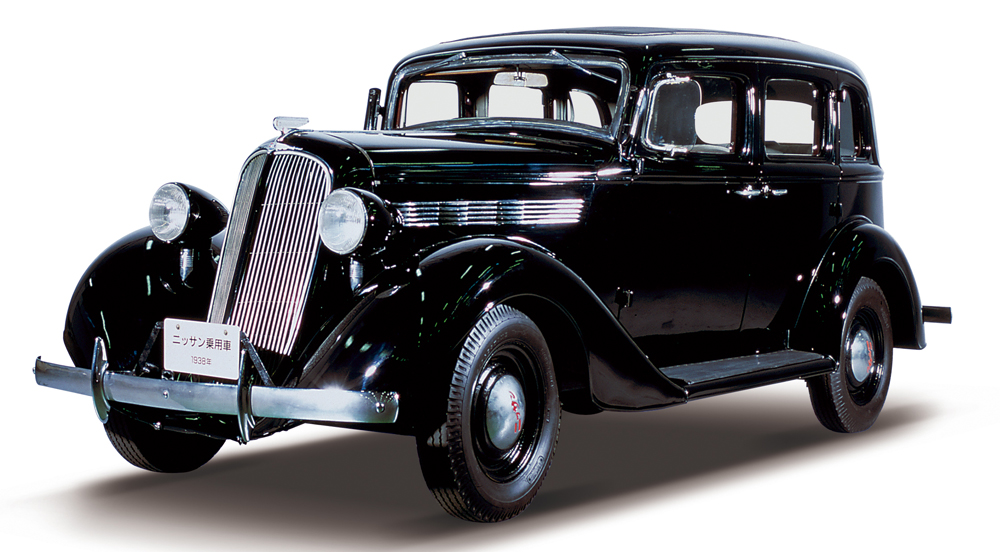
No.007 NISSAN Passenger Car (1938 : Type 70)
Until the introduction of corporate identity guidelines in 1981, two different car names (brand names) were used: small cars were called “Datsun” while large vehicles were named “Nissan”. The first NISSAN model was made with equipment purchased from an American company, Graham Paige Motors Corp., so the size of the vehicle was comparable to the Fords and Chevrolet at that time. The first car came off the line in March 1937.
Overall length…………………………………4,750mm
Overall width………………………………….1,720mm
Overall height…………………………………1,750mm
Wheelbase………………………………………2,794mm
Curb weight……………………………………1,410kg
Engine……………………………………………Type A (6-cyl. in line, SV), 3,670cc
Max. power…………………………………….63kW (85PS)/3,400rpm
Max. torque……………………………………226Nm (23kgm)/1,200rpm
Tires………………………………………………6.00-16-4PR
Seating capacity……………………………..5 or 7
Top speed………………………………………80km/h
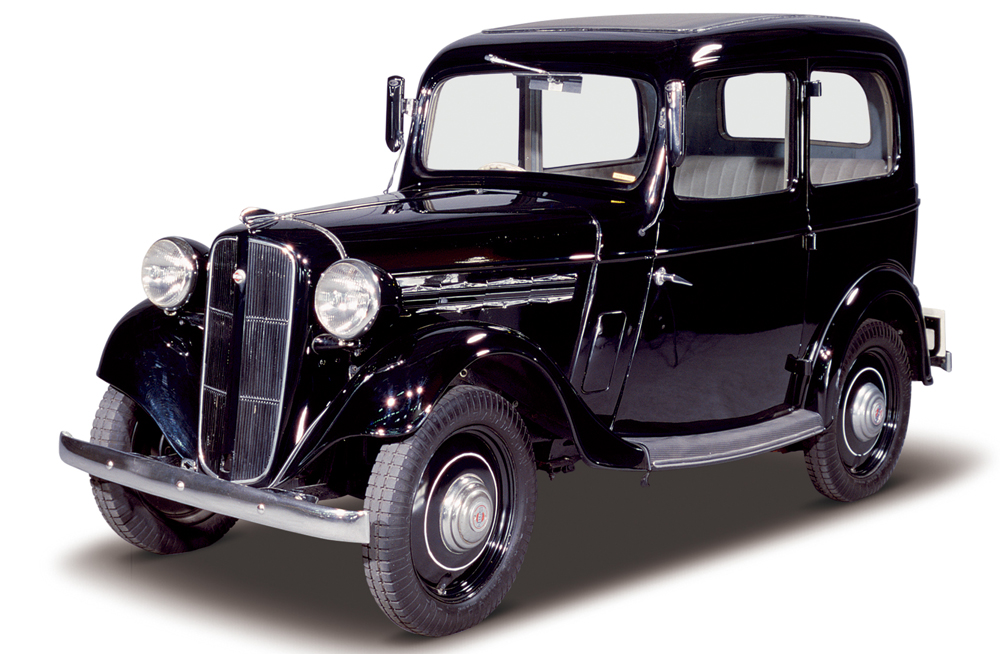
No.006 Datsun 17 Sedan (1938 : Type 17)
In 1938 Japan was already at war in China. The rugged and very economical Datsun was hugely popular. The exterior was not much different to that of the “16”, but a thick vertical bar in middle of the front grille distinguished it. As cotton and wool were scarce, the cabin interior had a very simple finish. The 722cc engine was a side valve (SV) design.
Overall length………………………………….3,187mm
Overall width…………………………………..1,190mm
Wheelbase………………………………………2,005mm
Curb weight……………………………………..630kg
Engine……………………………………………Type 7 (4-cyl. in line, SV), 722cc
Max. power……………………………………..12kW (16PS)/3,600rpm
Seating capacity……………………………….4
Top speed……………………………………….80km/h

No.008 NISSAN Van (1937 : Type 80)
Having obtained production equipment bought from the American company Graham Page in 1937, the company started production of a large vehicle – the “NISSAN”. The powerful 3,670cc, 85PS, 6-cylinder engine and Japan’s first semi-cabover design together made this a popular vehicle. This particular vehicle was used by the Mitsukoshi department store through the war years, from 1939 till 1965, to make deliveries.
Overall length*………………………………..4,338mm
Overall width*…………………………………2,161mm
Overall height*………………………………..2,655mm
Wheelbase*……………………………………..3,240mm
Tread (front/rear)*………………………….1,675/1,850mm
Engine……………………………………………Type AT (6-cyl. in line, SV), 3,670cc
Max. power……………………………………..63kW (85PS)/3,400rpm
Max. torque……………………………………..226Nm (23kgm)/1,200rpm
Transmission…………………………………..4-speed, floor shift
Seating capacity……………………………….2
*As measured
The “NISSAN” was Nissan’s first large vehicle, and it went on sale in 1938. You can say that this model laid the foundation for the later Nissan brand. It was actually a series that comprised a passenger vehicle (70), a van (80) and a bus (90); altogether 5,500 units were produced.
The Type 90 bus was a member of the NISSAN Series, popular for its advanced semi-cabover design and powerful 6-cylinder engine.

You must be logged in to post a comment.